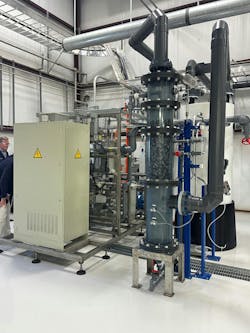Chemical Industry Advances PFAS Destruction and Removal Technologies
Key Highlights
- PFAS destruction technologies are advancing, with Lummus’s modular ZEO system demonstrating full PFAS elimination across industrial wastewater streams.
- Activated carbon reactivation offers a circular solution, reactivating spent GAC results in a cost savings of typically 20% to 40% over the purchase of virgin GAC.
- AI-driven material discovery is accelerating PFAS mitigation, as Kemira and CuspAI develop faster, more efficient water treatment materials.
By virtue of their strong carbon-fluorine bonds, per- and polyfluoroalkyl substances (PFAS) are thermally stable, chemically resistant and persist in the environment.
While research has identified links to serious health problems, much more is needed to fully understand the role of PFAS in them.
For industry, meeting current regulatory requirements and planning for future ones is driving advances in existing treatment technologies and pushing new ones from R&D into commercial use.
Granular activated carbon (GAC), electrochemical oxidation, photocatalysis and supercritical water oxidation are all in the technology mix when it comes to how industry is approaching the PFAS challenge.
For example, in April, Lummus Technology announced the successful startup and operation of a PFAS destruction demonstration unit at its Green Circle Labs facility in LaPorte, Texas.
The unit combines Lummus’s patented electro-oxidation and system integration for water and wastewater treatment technology with patented boron-doped diamond (BDD) electrochemical oxidation technology supplied by UK-based Element Six (E6).
Known as the Zimpro electro oxidation (ZEO) process, its success is due to the use of free-standing BDD electrodes. Unlike metal electrodes plated with BDD, these enable the high current densities that destroy the short-chain PFAS, which are a stumbling block for many treatment methods.
E6 and Zimpro, which Lummus acquired in 2023, developed ZEO, a process that has been commercially available for more than a decade.
After Zimpro became part of Lummus, the collaboration continued, and the demonstration unit is the latest iteration of the technology to emerge from the LaPorte facility (Figure 1).
“We have now successfully piloted the technology for PFAS destruction,” explained Greg Shumake, vice president and managing director of Lummus Modular Solutions.
The pilot projects involved multiple end users in drinking water, landfill leachate and industrial wastewater applications using a commercial-scale unit. The results indicate successful destruction of every type of PFAS identified in these real-world applications, converting them into inert salts.
“It is our goal to destroy all PFAS in the water, not just the five or six currently being regulated,” Shumake said. “Customers prefer this approach to avoid potential future liability or environmental risk.”
The companies designed ZEO as a modular concept, which allows for scale up to fit specific customer needs. A ZEO system can use up to four reactors, each with the capacity to destroy 2kg/hr of the compounds contributing to chemical oxygen demand (COD). If the application requires more than 8 kg/hr of oxidation capacity, additional ZEO units can be operated in parallel.
The system design allows for reactors to be added or removed during operation without shutting down the entire system. Each reactor has its own power supply and can be isolated for maintenance or installation while the rest of the reactors are operating.
ZEO can oxidize all components in a wastewater stream to the highest oxidation state possible, making them as destructive as possible to carbon-fluorine bonds, Shumake said.
The end products are benign salts that can be safely disposed of or discharged, such as sodium carbonate, sodium fluoride and sodium sulfate.
Lummus has applied this technology to many types of wastewaters from various industries and hasn’t found a single constituent in wastewater that the technology couldn’t destroy, Shumake said.
“It should be noted that ZEO is capable of not only oxidizing constituents that are soluble in water but can also destroy suspended particles such as microplastics,” Shumake said.
Modern GAC Reactivation
Using activated carbon in purification processes dates to the late 19th century. However, it wasn’t until the mid-20th century that development began on systematic reactivation processes aimed initially at destruction of traditional organic compounds.
Calgon Carbon, based in Pittsburgh, is developing the technology to remove PFAS for chemical operating companies, other processing industries and public utilities.
In testing, the reactivation process removed PFAS to non-detect levels, with destruction removal efficiencies (DREs) of over 99.999% under certain conditions, explained Lisa Reese, Calgon Carbon’s senior vice president for industrial solutions and diversified applications.
The process itself uses multiple destructive technologies, following the initial carbon reactivation furnace. The spent carbon then goes through thermal treatment and chemical scrubbing and particulate removal processes to reach its DRE figure.
Reactivating spent GAC typically results in cost savings of 20% to 40% compared to the purchase of virgin GAC.
Using a blend of pulverized high-quality bituminous coals is also important as sub-bituminous and other non-bituminous GAC materials present a low yield through reactivation, meaning incineration and landfill are the only disposal options, according to Calgon Carbon. Another advantage of this approach is that carbon bed segregation is retained after repeated backwashing.
“Thus, the use of activated carbon coupled with reactivation is a sustainable, circular solution for customers’ PFAS compliance needs,” she added.
According to Reese, activated carbon is expected to continue playing a significant role in PFAS removal, particularly in complex industrial applications where multiple treatment stages are necessary. The company is monitoring how emerging technologies might work alongside activated carbon systems, Reese said.
AI-Enabled Materials Discovery
Meanwhile, in July, Finnish company Kemira launched a strategic partnership with materials science AI company CuspAI.
The company, which focuses on developing sustainable chemical solutions, such as defoamers, antiscalants and biocides for water-intensive industries, will use CuspAI’s AI platform to accelerate the discovery and optimization of new products to deal with PFAS and other contaminants found in water (Figure 2). The platform has the potential to generate and analyze material properties 10 times faster with a significantly higher success rate than conventional methods, said Sampo Lahtinen, Kemira’s executive vice president of research and innovation.
“This AI can generate and evaluate new materials on demand,” Lahtinen said. “For example, you can request a material that selectively binds carbon dioxide under specified conditions — the AI then generates, evaluates and optimizes the potential molecular structures that meet those exact criteria.”
The collaboration is notable for its focus on water solutions and PFAS removal, Lahtinen said. "Most major public AI-materials discovery partnerships today are focused on batteries, coatings, or performance materials, not water," he added.
In addition to its R&D efforts, the company continues to advance on its activated carbon expertise with capital investments. Recent initiatives include acquiring a reactivation facility for granular and pelletized activated carbon in the UK and constructing a new reactivation plant in Helsingborg, Sweden, to serve the Nordic market.
"This plant (in Sweden) will enhance capacity for PFAS and micropollutant removal from drinking water and wastewater," Lahtinen noted.
Double Benefits of PFAS Water Treatment Systems
Advanced systems for removing PFAS from drinking water can help reduce levels of other harmful contaminants, too, according to a peer-reviewed study by Washington, D.C.-based Environmental Working Group.
Published in September in ACS ES&T Water, the study showed that existing technologies, including GAC, ion exchange and reverse osmosis, can reduce levels of known health hazards, including disinfection byproducts, agricultural nitrates and heavy metals such as arsenic and uranium in drinking water.
In the 19 U.S. utility water systems EWG studied, installation of advanced PFAS treatment technologies led to an average 42% drop in the level of trihalomethanes in drinking water, while haloacetic acid levels dropped 50%. The study notes that trihalomethanes and haloacetic acid are cancer-causing byproducts of water disinfection.
“PFAS treatment isn’t just about ‘forever chemicals,’” said Sydney Evans, EWG senior science analyst and lead author of the study. “It’s also opening the door to improving water treatment across the board. Advanced PFAS water treatment is a turning point that can help us clean up a broader mixture of contaminants and bring drinking water quality in line with today’s public health science.”
About the Author
Seán Ottewell
Editor-at-Large
Seán Crevan Ottewell is Chemical Processing's Editor-at-Large. Seán earned his bachelor's of science degree in biochemistry at the University of Warwick and his master's in radiation biochemistry at the University of London. He served as Science Officer with the UK Department of Environment’s Chernobyl Monitoring Unit’s Food Science Radiation Unit, London. His editorial background includes assistant editor, news editor and then editor of The Chemical Engineer, the Institution of Chemical Engineers’ twice monthly technical journal. Prior to joining Chemical Processing in 2012 he was editor of European Chemical Engineer, European Process Engineer, International Power Engineer, and European Laboratory Scientist, with Setform Limited, London.
He is based in East Mayo, Republic of Ireland, where he and his wife Suzi (a maths, biology and chemistry teacher) host guests from all over the world at their holiday cottage in East Mayo.



